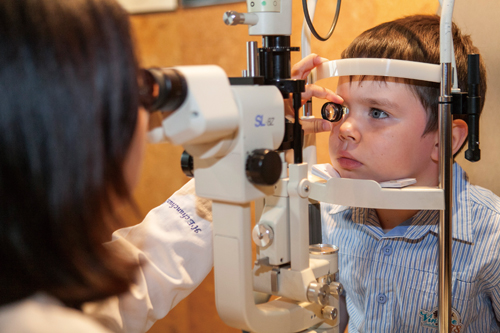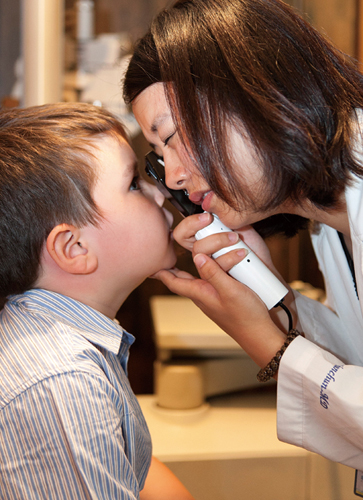 Though one of our primary senses is sight, many of us remain in the dark about eye health and eye care. Dentists remind us to brush our teeth, general practitioners tell us to eat an apple a day, but ophthalmologists lack a good motto. Though a lot of myths surround proper eye care, it’s often as simple as seeing a professional and making sure that children start seeing the eye doctor from a young age. We asked Dr. Chunchun He, supervisor of the VIP clinic at Intech Eye, and Dr. Kelly Wang, an ophthalmologist at OASIS Healthcare, to debunk some popular myths about eye health.
Though one of our primary senses is sight, many of us remain in the dark about eye health and eye care. Dentists remind us to brush our teeth, general practitioners tell us to eat an apple a day, but ophthalmologists lack a good motto. Though a lot of myths surround proper eye care, it’s often as simple as seeing a professional and making sure that children start seeing the eye doctor from a young age. We asked Dr. Chunchun He, supervisor of the VIP clinic at Intech Eye, and Dr. Kelly Wang, an ophthalmologist at OASIS Healthcare, to debunk some popular myths about eye health.
Myth 1: It Won’t Hurt to Put Off Seeing the Eye Doctor for Another Year
False. Children should see an ophthalmologist regularly. Perhaps the single most important step towards ensuring eye health is going for regular checkups at the eye doctor’s – and starting these visits early in life. The first eye check should come at 6 months of age, and the next ones should come at 3 years of age and 6 years of age. Dr. Wang calls these ages “the golden time” for finding and treating congenital eye conditions. For children over 10 years old, a checkup every two years is fine if there is no need for glasses. “If they have any other eye problems or refractive problems [or]they need glasses, an annual examination for eyes is very important,” says Dr. Wang.
Myth 2: Eating Carrots Results in Better Eyesight
True, with one caveat: Eat your carrots, but don’t skimp on the salmon and Omega-3s, either. One of the most common refrains about eye health is that eating lots of carrots will improve your eyesight. “Carrots are very rich in vitamin A and carotene,” says Dr. He, which “can help alleviate or prevent myopia [nearsightedness]and macular disease.” Carrots are definitely good for us, but Dr. He cautions that you can’t improve your vision; you can only prevent the loss of vision.
While Dr. Wang recommends lightly cooking carrots to help our bodies increase absorption of vitamin A and beta-carotene, she also strongly recommends that both children and adults get plenty of DHA (an Omega-3 fatty acid), which can be found in fish like salmon, sardines and mackerel. According to the DHA/EPA Omega-3 Institute, DHA is “a physiologically-essential nutrient in the brain and retina,” and is “actively deposited particularly during the last trimester of pregnancy and during the first two months of infancy and very early years of a child’s life.”
Myth 3: Screens Are Bad for Your Eyes
Partly true. While looking at screens won’t cause severe damage, it’s best to limit a child’s screen time. Now that iPads, iPhones, computers, and televisions are firmly ensconced in our daily routines, adults and children spend infinitely more time in front of a screen. Dr. He cautions that children “tend to forget to blink” when they look at a screen, which may cause a condition called dry eye syndrome. On the more serious side, kids can develop early myopia if they spend extended periods of time in front of a screen. Dr. He also explains that long screen sessions place a larger burden on eye muscles and make it harder for a child’s eyes to adjust to reading.
“Eye strain is very common in kids [who]watch television for a long time,” Dr. Wang points out, further cautioning that this can cause real damage to the eyes. Both Dr. Wang and Dr. He recommend that a child spend no longer than 30 minutes at a time in front of a screen. Kids should stand up, walk around, and look at something far away to let their eyes rest.
 Myth 4: Reading in Low Light Hurts Your Eyes
Myth 4: Reading in Low Light Hurts Your Eyes
Somewhat true. Kids should turn on the light and sit up straight when reading. Few children go through life without their parents encouraging them to turn on a light when they read for fear of going blind; while this may be an overstatement, Dr. Wang affirms that kids who read in dim light may weaken their eyes to the point that they won’t have 20/20 vision even while wearing glasses. She recommends reading in ample light and maintaining good posture. “Reading in dim light for a long time will also put your eyes at big risk for myopia because the muscle is always being stressed. This will cause eye strain and eye fatigue,” Dr. He agrees.
Myth 5: Sunglasses Are Just Fashion Statements
False. The entire family should wear sunglasses outdoors. “You can postpone the [onset of]presbyopia” if you practice this precaution, says Dr. Wang. Presbyopia is the progressive inability of the eye to focus on objects that are near, which affects many people over age 45. “Research shows that ultraviolet damage caused by the sun is cumulative [over one’s]lifetime,” says Dr. He, “so parents should really think about giving their children sunglasses to protect [them]from the beginning.” She adds that children should not wear sunglasses for extended periods of time indoors, as it can impact eye development.
Myth 6: Bloodshot Eyes Don’t Require Seeing a Doctor
False. You should take your child to the doctor if you think he or she has pink eye. Conjunctivitis, commonly called pink eye, is a very common eye disease among children. However, eyes can sometimes look pink and irritated even without conjunctivitis. No
matter what you think it is, take your child to the eye doctor. Pink eye may or may not be contagious, and seeing the doctor for correct medicine is necessary because antibiotics to treat pink eye in children are different than the antibiotics used to treat conjunctivitis in adults. Dr. He also cautions that red eyes “can be caused by multiple factors like infection or hemorrhage.”
Myth 7: Contacts Are Bad for Your Eyes
False, but it’s better to leave them to teens. Dr. Wang recommends that teenagers begin wearing contact lenses only after age 15 or 16, when they can take responsibility for cleaning the lenses thoroughly and understand the need to protect their eyes. Dr. He thinks that contact lenses are safer for teenagers active in sports, since glasses can easily be broken. She also believes that children as young as 13 can safely wear contact lenses, because “kids at age 13 are capable of handling the hygienic issues related to contact lenses.” Those who wear contact lenses should ensure the lenses are properly and frequently cleaned, and continue to see the doctor for annual eye exams.The biggest part of keeping eyes healthy is seeing an ophthalmologist regularly. But forming healthy habits like wearing sunglasses, eating a balanced diet with plenty of fruits, vegetables, and fish, and limiting time spent in front of a screen are easy ways to keep our eyes and bodies healthy for life.
Resources
Beijing Aier-Intech Eye Hospital
Daily 8.30am-4.30pm. 1/F, 4/F, 5/F, Panjiayuan Plaza, 12
Panjiayuan Nanli, Chaoyang District (400 012 0855, 6771 5558, customerservice@intecheye.com) www.intecheye.com 朝阳区潘家园南里12号潘家园大厦
OASIS Healthcare
Mon-Sat 9am-4pm, no appointments on Sundays; 24-hour emergency service. Bldg C1, 9 Jiuxianqiao Beilu, Chaoyang District (400 876 2747) www.oasishealth.cn 朝阳区酒仙桥北路9号C1栋
DHA/EPA Omega-3 Institute
www.dhaomega3.org
This article is excerpted from beijingkids August 2012 issue. View it in PDF form here or contact distribution@beijing-kids.com to find out where you can pick up your free copy.



